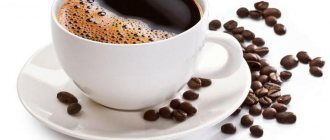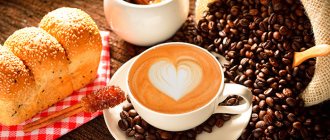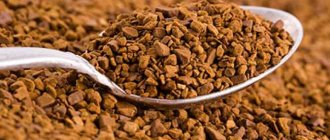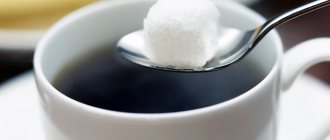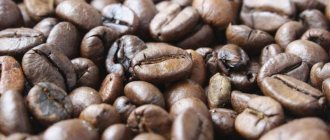Milk is the most popular additive in coffee. Most people prefer milk coffee drinks, as they are milder in taste and do not feel the bitterness or sourness of coffee. Any coffee shop has a huge selection of coffee and milk-based drinks, much more than pure black drink. Milk is poured hot and cold, whipped, and foam is made. Some add sugar, but most avoid it and drink their drinks as they are served. For those who control their diet, it is important to know the calorie content of coffee with milk without sugar.
Calorie content of natural coffee
The energy value of dry roasted coffee beans ranges from 230 to 330 kcal per 100 grams, depending on the variety. To prepare a serving of espresso, take 1 tablespoon of ground product, that is, approximately 10 grams. This means that one dose contains from 23 to 33 kcal. However, the calorie content of coffee without sugar and milk is not at all as high as it seems at first glance.
Coffee beans contain fats, carbohydrates and even proteins. During brewing, they only partially pass into the drink. The finer the grains are ground, the better the extraction. Fine grinding releases slightly more substances than coarse grinding. This has a slight effect on the final calorie content.
On average, a serving of espresso (30 ml) contains 1 kcal. Accordingly, a double espresso has 2 kcal.
A cup of Turkish coffee (200 ml) contains 3-4 kcal. The same amount of product is used to make it, but there are more nutrients in the drink due to longer cooking time and fine grinding.
During storage, the aromatic oils partially evaporate and the calorie content decreases slightly. It turns out that freshly roasted grains have the highest calorie content. But the difference is only 1 kcal per serving, so you shouldn’t give up fresh product for fear of damaging your figure. The same applies to the choice of grain type: Arabica is slightly more nutritious than Robusta (the difference is 0.5-1 kcal per serving) due to the higher content of aromatic substances.
- Read more: Arabica and Robusta - what is the difference
Sugar-free espresso is suitable for those who want to lose weight, because it hardly increases daily caloric intake and at the same time speeds up metabolism.
Flavored grains are twice as nutritious, but this means a difference of 2 kilocalories per serving that is insignificant for the daily diet.
Recipe: black coffee made from roasted ground coffee beans
1 serving 200 grams
Preparation technology: roasted coffee beans are ground immediately before use, in the quantity recommended for preparation. The container in which the coffee will be brewed is scalded. Pour in the ground coffee according to the norm and pour boiling water over it, bring to a boil, but do not boil. The finished coffee is allowed to settle and poured into a coffee pot or poured directly into cups and served.
The oriental method of preparing coffee is that it is prepared in a special container (turk or cezve). Ground coffee is poured with cold water and also brought to a boil until it begins to rise. This is done 2-3 times. A glass of cold boiled or mineral water is served with coffee.
Soluble product
Even without added sugar and milk, a drink made from granules or freeze-dried crystals has more calories than brewed coffee. The instant product contains practically no caffeic acids, fats, proteins and even caffeine, because it consists of only 15-20% of original natural raw materials. The rest is stabilizers, thickeners, and dyes. These additives make instant coffee more nutritious: on average, it contains from 6 to 12 kcal per one heaped teaspoon.
However, this indicator can vary greatly between different manufacturers. For example, a serving of Nescafe Gold contains only 4.5 kcal, but the same amount of Tchibo Exclusive contains as much as 20.
The nutritional value of instant coffee without sugar is 5-10 times higher than that of a product of natural origin.
Calculation of caloric content of a recipe per 200 grams
The calculation of the calorie content of 200 grams of the recipe is based on the summarized indicators of BZhUK (abbreviation: proteins-fats-carbohydrates-acid) of the ingredients from table (1) involved in the preparation. The data was taken from the database of the “products” section of the website and brought into line with the final yield of the dish (net).
Our example involves proteins - 1.11 grams, fats - 1.15 grams and carbohydrates - 2.36 grams, contained in 200 grams of the recipe. Next we perform the calculation:
Energy value of 200 grams of recipe = 1.11 (proteins)*4 + 1.15 (fat)*9 + 2.36 (carbohydrates)*4 = 4.44 + 10.35 + 9.44 = 24.2 kcal
With sugar
There are 15 kilocalories in 1 level teaspoon of sugar (about 5 grams). The same amount in one cube of refined sugar. Adding two servings of sweetness significantly increases the calorie content of a coffee cup: from 1-4 kilocalories to 30-34.
Sweet flavored syrups, which are sometimes used instead of granulated sugar, are no less nutritious. In 10 grams (the same 2 teaspoons) - from 30 to 40 kcal.
Vitamin content
table 2
| Vitamins | Content | Daily norm |
| E (α-, β-, γ-tocopherols) | 0.11 mg | 1.1 % |
| B1 (thiamine) | 0 mg | 0.2 % |
| B2 (riboflavin) | 0.01 mg | 0.4 % |
| B3 (PP) (nicotinamide) | 0.79 mg | 4.2 % |
Natural black coffee contains low levels of vitamins when considered according to approved food nutritional significance standards.
Vitamins of low content include:
- E, keeps the muscular system in good shape.
- B1, required to normalize the nervous and muscular systems.
- B2, maintains body tone.
- PP, participates in the formation of hemoglobin.
With milk and cream
The calorie content of dairy products depends on the fat content. The most dietary option is skim milk (0.1% fat). There are only 30 kcal in 100 grams, and 6 in a serving (20 ml). The most popular product is with a fat content of 3.5%. It is twice as nutritious - 60 kcal per 100 grams, or 12 per serving. And 6% fat milk is as much as 85 kcal per 100 grams, that is, 17 per serving.
The calorie content of coffee with milk without sugar can be significantly reduced if you choose a product with minimal fat content.
If you prepare the drink in a Turk, then 200 ml of coffee with milk without sugar is 15 kcal.
Coffee with cream is very tasty, but also very high in calories. Liquid 10% cream contains 120 kcal per 100 grams. If you add only 10 ml per cup, the energy value will increase by 12 kcal.
The energy value of instant coffee with milk (3.5%) is on average 20 kilocalories per 200 ml serving.
Directions
Natural black coffee
IngredientsDirections
Table 1
| Products | Weight | Squirrels | Fats | Carbohydrates |
| Water | 220 ml | 0 | 0 | 0 |
| Roasted coffee beans | 8 g | 1.11 | 1.15 | 2.36 |
| Exit | 200 | 1.11 | 1.15 | 2.36 |
With sugar and milk
Coffee with milk and various coffee and milkshakes, supplemented with granulated sugar or sweet toppings, should not be perceived as drinks, but as a delicacy. A sweet cappuccino or latte with cake is an unaffordable luxury for those watching their weight.
For example, a sweetened cappuccino that is 2/3 milk contains 150 kcal per 200 ml cup.
- More on the topic: Is it possible to drink coffee on a diet?
The calorie content of coffee with milk (20 ml) and sugar (1 teaspoon) is about 30 kcal.
Instant coffee with milk and sugar contains about 50 kilocalories.
Recommendations for those who watch their figure
Those who count calories and control their own weight do not necessarily have to exclude the morning ritual in the form of a cup of invigorating espresso or Americano. It is enough to follow simple rules, and then your favorite drink will not interfere with weight loss:
- You can't drink coffee on an empty stomach. This negatively affects the functioning of the gastrointestinal tract and contributes to excess weight gain.
- Only natural coffee brings benefits. The soluble product contains chemicals that negatively affect the body.
- You should observe the measure and not abuse the quantity: 1-2 cups of espresso or Americano per day is quite enough.
- Green grains contain more antioxidants than roasted ones, which helps speed up your metabolism and help you shed extra pounds.
- For those watching their weight, it is advisable to drink natural espresso or Americano without sweeteners or calorie additives. You can also use ground cinnamon, ginger, lemon. You are allowed to pour in a little low-fat milk.
Drink from a bag
The “laziest” method of preparation is a 3-in-1 drink. The bag contains dry vegetable cream, instant coffee, sugar and various additives. One dose, which is recommended to be dissolved in 200 ml of water, contains about 70 kcal.
Calorie table for different coffee drinks
| Coffee, ml | Kcal per 100 grams | Kcal per serving |
| Espresso, 30 | 3 | 1 |
| Ristretto, 15 | 3 | 0,5 |
| Americano, 200 | 0,5 | 1 |
| Natural black, 200 | 2 | 4 |
| Natural with milk, 200 | 7-8 | 15 |
| Natural with milk and sugar, 200 | 15 | 30 |
| Instant black without sugar, 200 | 3-6 | 6-12 |
| Instant with milk without sugar, 200 | 10 | 20 |
| Instant with milk and sugar, 200 | 25 | 50 |
| Coffee from a 3 in 1 bag, ml | 35 | 70 |
Natural, not very sweet coffee with medium-fat milk will not harm your figure, but will be a source of pleasant taste sensations. In addition, in addition to the insignificant 20-30 kilocalories, it contains vitamins and microelements. But a drink from a bag contains a lot of “empty” calories, so it’s better not to drink this product often.
Types of coffee drinks: how much milk and calories they contain
As a rule, milk coffee drinks are prepared on the basis of espresso, single or double. Different chains have their own recipes and volumes of the drink, and therefore the calorie content. The table below presents popular drinks from well-known chain establishments.
| Name of chain and type of drink | A portion | Calorie content |
| Coffeemania Cappuccino | 330 | 90 |
| Coffeemania Cappuccino | 450 | 160 |
| Coffeemania Latte | 330 | 156 |
| Coffeemania Latte | 450 | 218 |
| Coffeemania Flat White | 430 | 130 |
| CoffeeHouse Double Cappuccino | 100 | 64 |
| CoffeeHouse Latte | 100 | 44 |
| Chocolate Cappuccino | 100 | 35 |
| Chocolate Latte | 400 | 220 |
| Chocolate Cappuccino Light | 320 | 125 |
| Starbucks Cappuccino Grande | 350 | 140 |
| Starbucks Latte Grande | 350 | 220 |
| Starbucks Latte low fat | 350 | 112 |
| Starbucks Cappuccino low fat | 100 | 20 |
| McDonalds Cappuccino | 300 | 123 |
| McDonalds Latte | 300 | 132 |
Content of chemical elements
Table 3
| Elements | Content | Daily norm |
| Iron (Fe) | 1.53 mg | 10.94 % |
| Potassium (K) | 80.4 mg | 2.3 % |
| Calcium (Ca) | 10.83 mg | 1.08 % |
| Magnesium (Mg) | 9.1 mg | 2.28 % |
| Sodium (Na) | 2.59 mg | 0.11 % |
| Phosphorus (P) | 7.92 mg | 0.79 % |
At a high level of significance of the nutritional value of the chemical macro- and microelements of the product is Fe (iron), which is involved in blood formation.
Low level elements of this product include:
- K (potassium), helps the heart muscle work and removes unnecessary fluid from the body.
- Ca (calcium) is necessary for bone and dental tissues.
- Mg (magnesium), helps increase the activity of food enzymes.
- Na (sodium) actively participates in the formation of gastric juice for the digestion process and, together with potassium, maintains the salt composition of the blood unchanged.
- P (phosphorus), required by the skeletal system and teeth.
How to calculate calorie content if there are a lot of additives
Few coffee lovers drink it in its pure form. If there are a lot of additives, several cups of your favorite drink a day can be as dangerous for your figure as buns, chocolates or sausages.
Assess the nutritional value of ingredients added to coffee.
To determine the final calorie content of a cup of coffee (in the original product it is close to zero), you need to evaluate the nutritional value of the ingredients added to it and add up the resulting numbers. So, 3 tsp. sugar adds 75 kcal to the drink, 100 ml of skim milk - another 30. 50 g of creamy ice cream, which successfully highlights the taste of coffee, contains more than 100 kcal.
If you add up the energy value of all the above additives, a serving of double espresso with skim milk, 3 tablespoons of sugar and a scoop of ice cream will contain about 220 kcal.
Chemical composition of instant coffee
What beneficial substances are included in the instant drink, provided that it was made from natural coffee beans:
- calcium (5 mg/100 grams of product);
- iron (2 mg);
- phosphorus (7 mg);
- sodium;
- vitamins B1, B2;
- vitamin PP;
- nitrogen and other nutrients.
Energy value of different types of drink
Various coffee drinks are popular in coffee shops, restaurants, and catering establishments. Their recipe involves the addition of different ingredients that affect the total calorie content. Let's take a closer look at popular coffee drinks, their composition and final energy value:
- Espresso . This is the lowest calorie type, one serving (30 ml) without additives contains about 2 kilocalories. After adding one teaspoon of sugar, the number rises to 25. Properly prepared espresso itself is a self-sufficient drink that does not require additives. Just as wine connoisseurs enjoy a wine bouquet, coffee lovers enjoy the unique rich taste.
- Americano . Essentially, this is the same espresso, only diluted with hot water in a ratio of 1:4. This way the drink softens the bitterness and becomes less strong. The calorie content of 250 ml of Americano is also 2 kcal.
- Latte . This is an Italian recipe in which steamed milk is added to the classic double espresso. One serving (220 ml) contains 180-220 kilocalories. Sometimes grated chocolate or ground nuts are sprinkled on top of the glass. In this case, the calorie content of a serving increases to approximately 250 kcal. Lattes are sometimes confused with a similar drink called flat white. They are indeed similar in recipe, differing only in the method of serving and the presence of dense snow-white foam in the latter, while in latte it has a brownish tint.
- Glasse . The traditional recipe for this delicious drink originated in Austria. Here, for the first time, they began to add ice cream to classic coffee, creating both an invigorating and refreshing ice cream. Served in a tall glass with a volume of 350-400 ml, the share of ice cream in it is about a fifth (about 60 g). The traditional recipe reaches 120-150 kilocalories in calorie content. Often grated chocolate, nuts, coconut flakes, honey, cinnamon are added to such a “cocktail”, then the calorie content can increase to 200 kcal.
- Raf . This is a coffee cocktail with a milky-creamy taste, delicate texture and subtle vanilla aroma. It is prepared using espresso, cream and sugar. It cannot be called a diet drink; it is a full-fledged dessert due to a significant proportion of cream and sugar (regular or vanilla). Its calorie content reaches 180-200 kcal, and various flavoring additives significantly increase it.
- Mocaccino (mocha) . A coffee drink with a pronounced chocolate flavor. The recipe requires the use of 3 main ingredients: espresso, milk and chocolate (it can be replaced with chocolate syrup or diluted cocoa powder). Sometimes it is prepared in layers: melted chocolate on the bottom, hot milk and espresso on top, and can be decorated with whipped cream. But some people prefer to mix chocolate with milk. The calorie content of such a drink depends on the chocolate used in preparation. On average, 100 ml of cocktail contains 250-270 kilocalories.
- Irish . This is an Irish coffee drink recipe, hence the name. In classic preparation, whiskey, espresso (in a 1:2 ratio), as well as 2 tablespoons of farm cream and a teaspoon of sugar are used. One serving of this cocktail contains about 250 kilocalories. There are different variations of the traditional recipe.
- Romano . This is coffee with the addition of lemon juice and zest. It is also called Italian espresso. The calorie content of this drink is only 4 kcal, which is explained by the absence of other energy supplements.
How many calories are in a cup of coffee
Obviously, the calorie content of one cup of coffee can vary greatly depending on the recipe and additives. We can only say for sure that pure espresso is a low-calorie product; one cup contains only 2 kilocalories. Therefore, it can even be called a diet drink.
One teaspoon of sugar added to a cup of espresso increases its energy value by up to 25 kcal.
If you are interested in how many calories are in coffee with milk and sugar, then add another 10-15 kilocalories to the resulting caloric intake (may vary depending on the percentage of fat content of the milk and its amount in the cup). The nutritional value of popular coffee drinks and various additives has already been discussed above.
Thus, connoisseurs of pure coffee taste without sweeteners and additives need not worry at all about its effect on their figure. This option is recommended for people on a diet, who play sports, and adhere to the principles of proper nutrition, who are accustomed to counting calories.

